(Strand)om Stories: Captain America: Operation Rebirth Review
This 90s run is a celebration of Captain America's character, wrought by a writer who strikes at the heart of the American hero
—by Nathan on July 3, 2025—
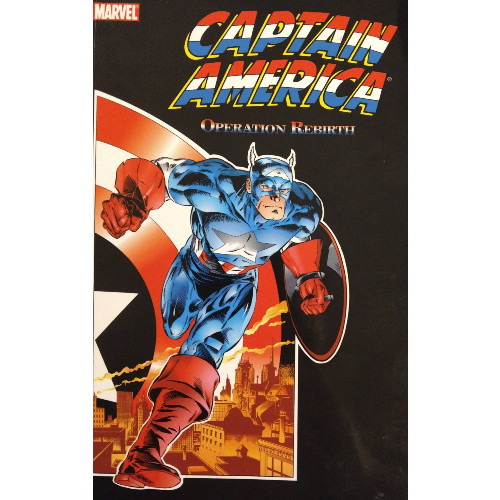
I guess July 3 has just become "Post a Captain America review" day for me, given last year I discussed Roger Stern and John Byrne's short-and-sweet run on the good Captain's main title, as well as a series of Marvel Knights issues I felt less enthused about a few before that. Worse ways to celebrate "Independence Day Eve," I imagine.
I did an early 2000s volume a few years back and covered stories from the 80s a year ago. We're planting ourselves in the middle this year, in the "dark ages" of comics, to ask an important question: what do you do when you're the Star-Spangled Man with a Plan…and no plan can save you?
Such was the question Steve Rogers faced at the end of Mark Gruenwald's eleven-year-run. Told in a 1994 issue that the very super soldier serum which gave him his abilities was killing him, Cap chose to push himself instead of lying down and dying. Donning a Tony Stark-invented exoskeleton to replace his flagging strength, Cap continued fighting until he could fight no more…and only then, it seemed, did he lay down to die.
Gruenwald's last issue ended with the Avengers looking in on their friend and finding his exoskeleton, yet without a man inside it. Captain America was gone! Dead? Kidnapped? Gruenwald passed the torch to Mark Waid, who wrote the series until Marvel's "Onslaught" event sucked Cap into a parallel universe. This volume collects most of Waid's run leading up to "Onslaught," answering the question of whatever happened to Captain America…and what does he do now?
As Cap made an appearance in that 90s ball of excess I recently reviewed, "Maximum Carnage," I wanted to see if there were any well-written Captain America stories from the same decade. Aside from Gruenwald's work (which I hope to review later down the line in a different format), Waid's time on the book prior to "Onslaught" consistently came up in blogs and discussion boards I visited. Part of me had always wanted to check out Waid's run, so I took this as an opportunity. Today, to celebrate both America's birthday and Waid's time on the title, we'll look at what he wrung out of the old red, white, and blue.
Captain America: Operation Rebirth
Writer: Mark Waid
Pencilers: Ron Garney and Pino Rinaldi
Inkers: Scott Kobbish, Mike Sellers, Denis Rodier, and Mike Manley
Colorists: John Kalisz and Paul Becton
Letterer: John Costanza
Issues Collected: Captain America #444-448, #450-454
Volume Publication Date: January 2008
Issue Publication Dates: October 1995-February 1996, April 1996-August 1996
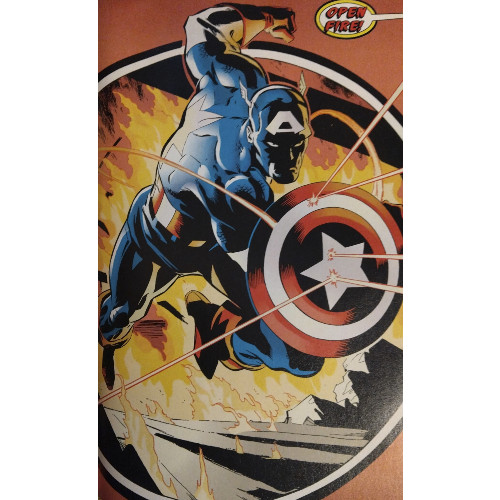
Mark Waid nails characters. Whether he's distilling Superman down to his core essentials or wrangling together the offbeat chemistry driving a very human Justice League, the man can peer beneath the surface to find the heart(s) of whatever hero(es) he's writing. So when he's writing Captain America, you would expect him to gaze deep beyond the big white star on Steve Rogers' chest and find what makes his heart tick: a stirring adoration for the country he so valiantly protects.
And that's why Waid teams Cap up with the Red Skull.
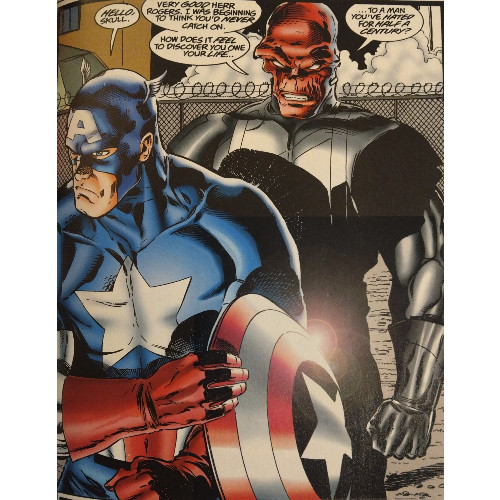
I make light of the scenario, not to besmirch Waid, but to hit on one of the themes found across this volume: though he adamantly loves the United States of America in its then-current form, Rogers is foremost the purest form of patriot…and not one defined by human standards. He's not a nationalist, fervently defending one party or one person. His cause runs deeper than people. Frank Miller touched on this in "Daredevil: Born Again," in a scene where Cap tells a high-ranking official, "I'm loyal to nothing General–except the dream." That "dream," of a USA safe and secure, regardless of who's in charge (and, at times, in defiance of who's in charge), motivates the spirit within Cap.
And, yes, that means he sometimes teams up with the Red Skull…but make no crimson bones about it, he's just as interested in keeping the Skull from dooming humanity as he is using the fiendish, long-lived Nazi to complete his own purposes.
Thus, Waid uses his opportunity–a seemingly dying, if not dead, Captain America at the end of Gruenwald's run–to revitalize the hero by challenging that very notion. I've not read Gruenwald's run, but I get the sense that, though it maintained significant quality throughout the 80s, it had lost some of its sheen in the 90s. Cap donned the big ole suit of armor that almost every hero seemed to use at one point or another. Waid pulls him back from the brink of death, rejuvenating the hero by removing that which made him special: the super soldier serum. Now left to his own skills, Cap is forced to rely on his own willpower, strength, and beliefs to guide him through adventures which pit him, at moments, against the U.S. military and put him at odds with then-POTUS Bill Clinton.
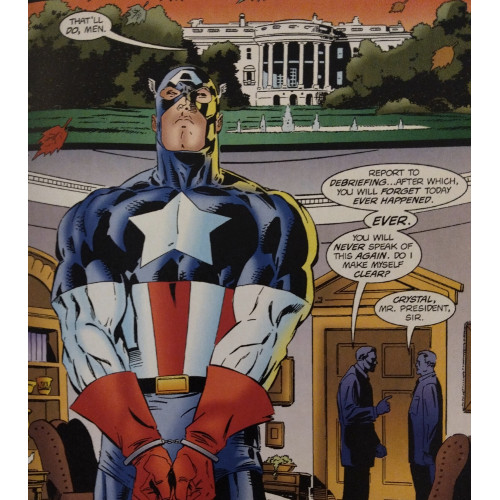
Waid weaves in enough tension that the reader is meant to question Cap across two overarching stories, one which sees Cap team with the Skull, the other which sees Cap temporarily exiled from the U.S. You would think narratives where Cap teams with a Nazi supervillain and spends most of his time estranged from his homeland would make the character feel the opposite of himself, a very Captain Un-America. But it doesn't, and it goes back to the idea that Waid capably embraces a deeper side of Steve Rogers. The only reason Steve is exiled is because of actions he takes because he believes in defending America and her people–heck, when he later travels back to America in the hopes of stopping an assassination attempt, it's in defiance of presidential orders, but his intentions are to prevent a blow to the country. Cap doesn't get enmeshed in the rigamarole and red tape of politics; he slices through it, and though there is a more legalistic side of my brain which wants to shake my head and scold the good Captain for his actions, I can understand and appreciate his own brand of civil disobedience.
Waid uses the Cap/Skull team-up specifically to wonderfully illustrate this point–though Cap is sided with his most hated enemy, there are lines he refuses to cross and ideologies he refuses to embrace…most of the time. Here and there, Cap finds himself acting in ways he himself stoically feels opposed to, and in these moments, Waid capably provides inner turmoil. When Cap finds he must resort to a particular action to prevent the Red Skull's latest scheme, Waid allows him a few moments of brooding reflection. Ron Garney dials back the details, with dark shadows crossing over the captain as he gives in to a moment of personal frustration, knowing he's let himself down while believing, even begrudgingly, that he may not have had another choice.
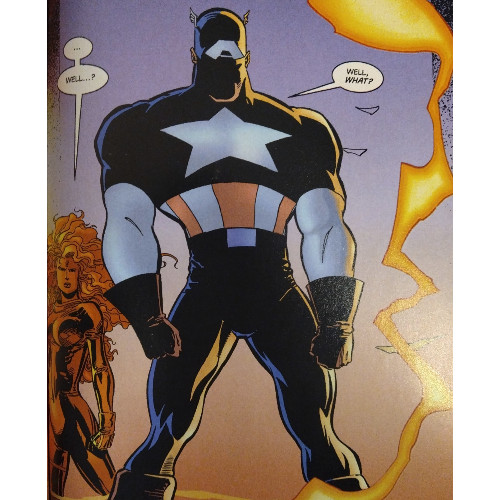
Fans bemused by the temporary Cap/Skull crew may be intrigued by the reintroduction of another character: Cap's old flame, Sharon Carter, niece of his other, older flame, Peggy Carter. Sharon, believed dead since 1979, makes a triumphant return, and Waid seems to take a certain amount of joy having readers realize she's not the same Sharon Carter Cap fell in love with. As someone who isn't deeply aware of Cap's history, I remember being blindsided by the MCU's Falcon and the Winter Soldier series' take on the character, totally caught off-guard by how Sharon became a darker, somewhat antagonistic version of herself. Her turn, I'd argue, can find its roots in these comics–Sharon is still an agent on the side of angels, but the experiences between her "death" and her return have made her jaded. She brings a level of practicality and solemnity to these issues, keeping them grounded. There's a sense she provides a slight counterweight to Cap–his constant, spirited upholding of core American principles clash at moments with Sharon's broken ideas. They have both seen the grittier, besmeared side of the country, the side which sometimes kills hope, and each give in to different responses. In one, powerful moment, however, Waid allows Sharon to loosen her grip somewhat, letting her behave in a way which sets aside her antagonism to rescue former colleagues. Her own wrestling, much like Cap's, indicates her development as an individual, culminating in this single moment which notes that, also much like Cap, there are just some beliefs she can't completely set aside. It's a much better take on the character than the Disney+ rendition.
The characters are strong, the plotting is solid, and the action is well-wrought by Ron Garney. We're given a bevy of thriller action sequences, including Steve and Sharon's harrowing escape from a downed plane, a battle atop a train, a showdown on a runway, and some fun set pieces during World War II. If any complaint can be found, it's in that Waid finds a somewhat convenient way to bring Cap back to America to wrap up his second story. It's not a complete deus ex machina moment, but there is a "this just so happened to work out conveniently" aspect to the development. But that's an incredibly minor complaint regarding a minuscule dent in this volume's vibranium shield.

In Captain America #444, while the Avengers believe Cap is dead, Hercules remarks, "On Olympus, we measure wisdom against Athena…speed against Hermes…power against Zeus. But we measure courage…against Captain America." That's a huge claim to make, that mythological gods have been so impressed by Steve Rogers that they use him as a benchmark for bravery. Waid manages to have that claim ring true, as Cap proves time and again he's absolutely a litmus test for courage. You see it not only in the way he runs towards men with guns, bombs, and Cosmic Cubes, but in the way he staunchly defends truth. Waid gives himself a heckuva thesis statement to defend right off the bat, and he manages to back it up, showing the kind of hero Captain America is…even if it means teaming up with the Red Skull.*
*Under false pretenses, so it's totally okay! Call it a "Red Skull herring."